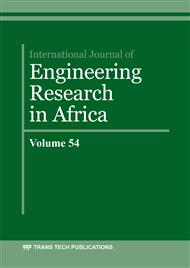[1]
J. D. Eshelby, The determination of the elastic field of an ellipsoidal inclusion, and related problems. Proc. Roy. Soc. Mathematical and physical sciences, A241, 1957, 376–396.
DOI: 10.1098/rspa.1957.0133
Google Scholar
[2]
Z. Hashin, The elastic moduli of heterogeneous materials, Journal of Applied Mechanics. 29, 1962, 143-150.
DOI: 10.1115/1.3636446
Google Scholar
[3]
R.M. Christensen, K.H. Lo, Solutions for effective shear properties in three phase sphere and cylinder models. J. Mech. Phys. Solids 27 (4), 1979, 315-330.
DOI: 10.1016/0022-5096(79)90032-2
Google Scholar
[4]
E. Hervé and A. Zaoui. Modelling the effective behaviour of nonlinear matrix-inclusion composites. European Journal of Mechanics - A/Solids, 9, 1990, 505-515.
Google Scholar
[5]
E. Hervé, A. Zaoui. Inclusion-based micromechanical modelling. International Journal of Engineering Science. 31, 1993, 1–10.
Google Scholar
[6]
E. Hervé, A. Zaoui, Elastic behaviour of multiply coated fibre-reinforced composites. International Journal of Engineering Science. 33 (10), 1995, 1419–1433.
DOI: 10.1016/0020-7225(95)00008-l
Google Scholar
[7]
H. Moussaddy, D. Therriault and M. Lévesque, Assessment of existing and introduction of a new and robust efficient definition of the representative volume element, International Journal of Solids and Structures, 50, 2013, 3817-3828.
DOI: 10.1016/j.ijsolstr.2013.07.016
Google Scholar
[8]
J. Talbot, P. Schaap, G. Tatjus, Random sequential addition of hard spheres, Molecular Physics: An International Journal at the Interface Between Chemistry and Physics, 72:6, 1991, 1397-1406.
DOI: 10.1080/00268979100100981
Google Scholar
[9]
E. Ghossein and M. Lévesque, A comprehensive validation of analytical homogenization models: The case of ellipsoidal particles reinforced composites, Mechanics of Materials, 75, 2014, 135-150.
DOI: 10.1016/j.mechmat.2014.03.014
Google Scholar
[10]
A. A. Gusev, Representative volume element size for elastic composites: a numerical study. Journal of the Mechanics and Physics of Solids, 45, 1997, 1449-1459.
DOI: 10.1016/s0022-5096(97)00016-1
Google Scholar
[11]
H. Altendorf and D. Jeulin, Random-walk-based stochastic modeling of three-dimensional fiber systems. Physical Review E, 83, 2011, 041804.
DOI: 10.1103/physreve.83.041804
Google Scholar
[12]
http://www.zset-software.com/.
Google Scholar
[13]
T. Kanit, S. Forest, I. Galliet, V. Mounoury, D. Jeulin, Determination of the size of the representative volume element for random composites: statistical and numerical approach. Int. Journal of Solids and Structures. 40, 2003, 3647–3679.
DOI: 10.1016/s0020-7683(03)00143-4
Google Scholar
[14]
D. Jeulin, Caractérisation Morphologique et modèles de Structures Aléatoires, Homogénéisation en mécanique des matériaux (tome1). Hermes, France, (2001).
Google Scholar
[15]
Y. Djebara, A. El Moumen, T. Kanit, S. Madani and A. Imad, Modeling of the effect of particles size, particles distribution and particles number on mechanical properties of polymer-clay nano-composites: numerical homogenization versus experimental results, Composites Part B, 86,2016, 135-142.
DOI: 10.1016/j.compositesb.2015.09.034
Google Scholar
[16]
M.S. Boutaani, S. Madani, K Fedaoui, T. Kanit, Evaluation of effective mechanical properties of complex multiphase materials with finite element method, U.P.B. Sci. Bull., Series D, 79, Iss. 3, (2017).
Google Scholar
[17]
A. El Moumen, A. Imad, T. Kanit, E. Hilali, H. El Minor, A multiscale approach and microstructure design of the elastic composite behavior reinforced with natural particles. Composites Part B: Engineering. 66, 2014, 247-254.
DOI: 10.1016/j.compositesb.2014.05.008
Google Scholar
[18]
A. El Moumen, T. Kanit, A. Imad, H., El Minor, Effect of overlapping inclusions on effective elastic properties of composites. Mechanics Research Communications. 53, 2013, 24-30.
DOI: 10.1016/j.mechrescom.2013.07.007
Google Scholar
[19]
A. El Moumen, T. Kanit, A. Imad, H., El Minor, Effect of reinforcement shape on physical properties and representative volume element of particles-reinforced composites: Statistical and numerical approaches. Mechanics of Materials. 83, 2015, 1-16.
DOI: 10.1016/j.mechmat.2014.12.008
Google Scholar
[20]
L. Chaibainou, M. S. Boutaani, K. Fedaoui, M. S. Chebbah, Evaluation of thermal expansion of (Al-SiC) material using homogeneization method coupled to finite element method, U.P.B. Sci. Bull., Series D, 81, Iss. 4, (2019).
Google Scholar
[21]
E. Ghossein and M. Lévesque, A fully automated numerical tool for a comprehensive validation of homogenization models and its application to spherical particles reinforced composites, International Journal of Solids and Structures, 49 (11-12), 2012, 1387-1398.
DOI: 10.1016/j.ijsolstr.2012.02.021
Google Scholar
[22]
M. Pahlavan, H. Moussaddy, E. Ghossein. 2013. Prediction of Elastic Properties in Polymer-Clay Nanocomposites: Analytical Homogenization Methods and 3D Finite Element Modeling. Computational Materials Science.
DOI: 10.1016/j.commatsci.2013.06.029
Google Scholar
[23]
J. Dirrenberger, S. Forest, D. Jeulin, Computational Homogenization of Architectured Materials, Architectured Materials in Nature and Engineering, 282, (2019).
DOI: 10.1007/978-3-030-11942-3_4
Google Scholar
[24]
Z. Hashin, Assessment of the self-consistent scheme approximation: conductivity of particulate composites. J. Compos. Mater. 2(3), 1968, 284–300.
DOI: 10.1177/002199836800200302
Google Scholar
[25]
R.A. Fisher, The correlation between relatives on the supposition of Mendelian inheritance, Philosophical Transactions of the Royal Society of Edinburgh, 52, 1918, 399-433.
DOI: 10.1017/s0080456800012163
Google Scholar


